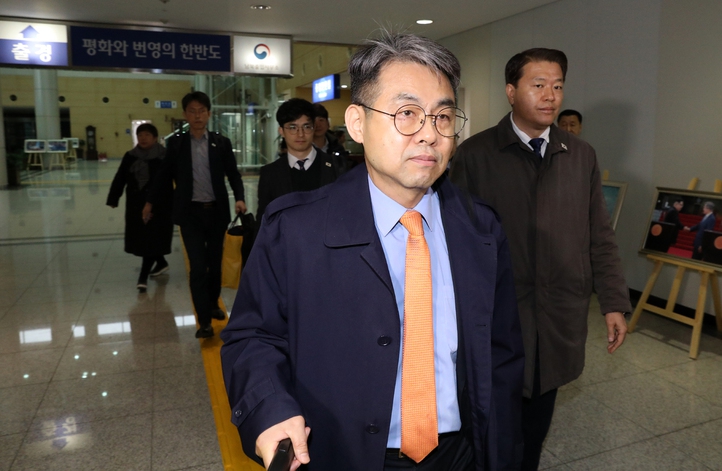Posted on : Mar.26,2019 16:53 KST
Modified on : Mar.26,2019 16:57 KST
 |
|
Kim Chang-su, South Korean Secretary General of the inter-Korean joint liaison office, and South Korean staffers of the joint liaison office depart for Kaesong from the Customs, Immigration and Quarantine (CIQ) office in Paju, Gyeonggi Province, on Mar. 25. (joint photo pool)
|
On Mar. 25, North Korea resumed its operations at the Kaesong inter-Korean joint liaison office three days after withdrawing its workers. A portion of the North Korean staff reported for work as usual that morning, with the North Korean representative explaining that they had “come down today to perform their usual shift duties.” While their return to work comes three days after the North’s abrupt announcement that it was withdrawing its staff on “orders from their superiors,” the actual absence amounted to two days over the weekend before they reported for work on Monday morning – no real vacuum in terms of duties. This swift return by the North is quite a welcome development.
The fact that only four to five North Korean working-level staffers reported to the liaison office that day – roughly half the usual number – suggests the operational system on their side has not yet returned completely to how it was before the withdrawal. But the North Korean employees are reportedly to conducted normal operations, agreeing as usual to a meeting between the two sides’ liaison representatives that morning. During that same meeting, the North Korean side is reported to have said there was “no change in our position that joint liaison office duties must be performed well in keeping with the aims of the inter-Korean joint statement.” This too is welcome as a clear sign of its commitment to normal operations at the Kaesong joint liaison office.
For now, there is no way of knowing what developments in the North Korean policy decision-making lineup occurred surrounding the sudden withdrawal from and return to the liaison office. Analysts attributed it to anything from behind-the-scenes inter-Korean communication to the possible influence of US President Donald Trump’s order to cancel additional sanctions targeting North Korea. Whatever the circumstances, we hope that the joint liaison office – which was established with some difficulty in September of last year – is now able to properly perform its role as a communication channel between South and North.
The Korean Peninsula has been facing some serious turbulence since the collapse of the North Korea-US summit in Hanoi late last month. We have seen no concessions on either side from the US, which wants a “big deal” on the nuclear issue, and North Korea, which favors a “step-by-step” approach. Under the circumstances, Pyongyang may have sensed a need to adjust the tempo with inter-Korean relations as well. Indeed, we have seen a number of instances in the past where souring North Korea-US relations led to a step backward for inter-Korean ties.
When it comes to solving problems, that sort of thing is not helpful. If anything, it is very likely to turn South Korean and international opinion further against the North, which will have the long-term effect of leaving Pyongyang with less room to maneuver. Times like these call for efforts to establish a positive feedback loop between improvements in inter-Korean and North Korea-US relations. Inter-Korean relations are not a subordinate variable to South Korea-US relations. They need to be actively improved as a way of breathing new life into relations between Pyongyang and Washington.
Please direct comments or questions to [english@hani.co.kr]









